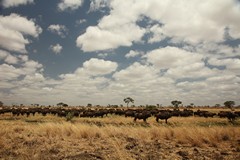
Clouds are building up prior to the onset of
the rains in late October or early November.
The grasses are dry and burnt but still support
huge herds of buffalos, as long as they have
adequate water for a daily drink. Processing
this grass requires a lot of water
The first thing you notice on leaving the aeroplane is the heat. This is the hot dry season, and everything is hanging on awaiting the arrival of the first showers of the short rains sometime this month. Some days are absolutely cloudless and the sun bakes the earth and further scorches the dry bush. Other days clouds bubble up, and give a welcome relief from the harsh sunshine. There is a promise of rain to come soon.
The presence of year round water in the rivers is critical to the welfare of the wildlife at this time of year. The water means that animals like buffalos and zebras, which are able to subsist on long coarse and dry grasses, can stay in the park all year round. Similarly, elephants are thriving.
Sadly this situation is rapidly changing. In the last 15 years the number of permanently flowing rivers has decreased from 14 to just 2. This is largely due to increased extraction in the Nyambene hills for agriculture and to a lesser extent by climate change. Without permanent flows the ecosystem will radically alter.
All of the rivers in the park show significantly decreased flow by October. The Rojowero still has enough water in it at several large pools to support pods of the resident hippos.
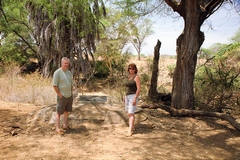
Elsa's grave on the bank of the Ura river.
Elsa died from a tick borne disease called
Babesia. She was only 5 years old
Some of the smaller rivers may have dried up completely but plenty of others such as the Murera and the Mutundu were still flowing. The Ura river was reduced to a series of small pools when we looked at it near to Elsa's grave.
The permanent swamps in the North West of the park attract and hold huge numbers of buffalo and it is common to see herds of 400+ in these areas. Plenty of other game and a wide variety of bird life can be seen on the edges of the swamps.
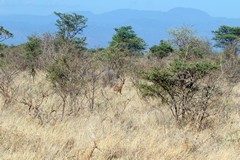
Typical gerenuk habitat. You'd have a much
harder time seeing one in the green season
As it is so very dry there is a only a low risk of malaria; I don't recall seeing a single mosquito. Neither were Tsetse flies a problem.
Another good reason to visit at this time of year is that the lack of leaves on much of the bush greatly improves the chances of spotting the wildlife. Gerenuk and lesser kudu were both easier to spot than they were in the greener season in June. Elephants seem to be pretty widespread, although the best game viewing is in the North and West of the park, and in the North of Bisanadi.
The dry bush and impressive sunsets leave a lasting impression and October is probably the best time of year to visit, for reasons given above.
Lions with cubs were seen on several occasions. It's reckoned that there may be around 80 lions in the park, following the results of a survey done by KWS in 2015. Bushmeat snares remain a great threat to them. Over 1000 snares were removed in one month in 2017.
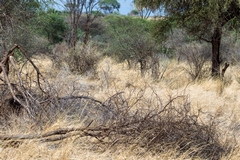
Cheetahs are scarce in Meru but can be seen
either stalking or hunting in the more open
areas. They don't always use a high speed
chase to make a kill
Cheetahs were seen on several occasions in the more open grassland. There were only about 6 of them in Meru in 2016. They are only present in about 23% of their historical range in Kenya, and globally numbers are down to only 7100.
Other predators to note and hopefully to see at this time of year are leopards, servals and honey badgers.
As we traversed the park going South towards the Tana river we noticed that the bush got thicker and taller, until
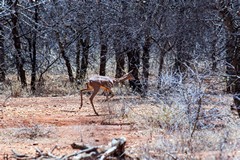
On the road to the Tana river further south
the bush is thick and almost impenetrable
with enormous spikes on virtually every plant.
Only a few gerenuk and dik-diks seem to be
able to cope in this arid place
there were almost no open spaces, except for the occasional small clearings, and the surrounding bush became thornier and thicker and pretty well impenetrable by medium to large mammals with normal hides. It was probably ideal habitat for black rhinos, and no doubt elephants could force paths through it, as they do in the rhino sanctuary, but generally all that was spotted for many miles as we approached the river were the occasional dik-diks and gerenuk. I would say it was the harshest bush we've ever seen, but with a primeval atmosphere all of its own, and I'd recommend a drive down to the Tana.
One warning though - as you drop down towards the river
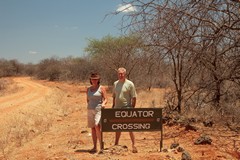
Since the tourist camps are in the north of
the park, a trip to the Tana river and
Adamson's falls will take you across the
Equator
the temperature climbs. By the time we reached the river it was at least 40 degrees. Not a place to spend any time standing in the sun, but still worth the trip to see Adamson's falls and the sheer size of the Tana.
A sad fact to note; there are herds of cattle encroaching the south of the park near to the Tana. Where these cattle have been able to get access there is barely a blade of grass left. There is also illegal grazing to some extent in Bisanadi reserve. This overgrazing of the land is reaching a crisis point in Kenya, particularly in the northern rangelands, and is the cause of massive environmental degradation over millions of a acres of land. If the issue is not addressed it will spread, as it has done in Laikipia, causing untold loss of wildlife.

Adamson's falls on the Tana river at the
crossing between Meru and Kora NP
The white rhinos were easy enough to see, and at the time of our stay the extended portion of the rhino sanctuary had still not been opened due to elephant damage to the fences. There are some very large bulls living in the rhino sanctuary. It is a deliberate policy to encourage them as they are good at opening up the bush and benefit the rhinos as well. As usual the black rhinos were well hidden and can only be seen if they choose to show themselves.
On the birdlife front, the winter migrants were beginning to arrive. There were no Carmine bee-eaters though. Wherever I go, I always seem to just miss them.
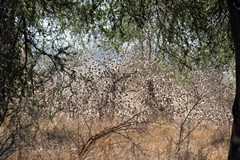
The huge flocks of red-billed queleas are
absolutely fascinating to watch as they move
through the bush feeding. It's amazing that
they all manage to miss each other. Queleas
are the World's most numerous bird
This time of year is also good to find huge flocks of red-billed queleas comprising of hundreds of thousands of individuals. They progress in short flights of maybe 50 metres or so, and then descend on a patch of ground for a minute or less to feed, then all take off and move again, like an advancing horde. It is mesmerizing to watch.
I should also mention that the roads in Meru, apart from the main ones, are some of the bumpiest and bone jarring that we have encountered anywhere. Progress down them can be extremely slow. Also, expect to come back to camp covered with a fine patina of the characteristic red dust.
Having said all that, I would highly recommend a visit to
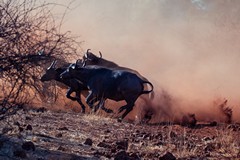
Red dust is characteristic of Meru, and you
and your possessions will be coated in it
Meru at this time of year. It's hot, but not uncomfortably so, and the evenings cool down enough to make sleeping easier, especially with the tent curtains left open. That can be an interesting experience; we woke one night to see several waterbuck grazing right outside the back of the tent, about three feet from my head. Elephants too were seen and heard in camp by day and by night.
Watch the two Meru in October videos.